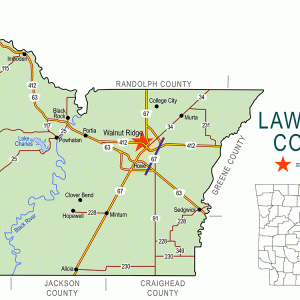calsfoundation@cals.org
Strawberry (Lawrence County)
| Latitude and Longitude: | 35°58’03″N 091°19’16″W |
| Elevation: | 341 feet |
| Area: | 2.34 square miles (2020 Census) |
| Population: | 268 (2020 Census) |
| Incorporation Date: | March 5, 1965 |
Historical Population as per the U.S. Census:
|
1810 |
1820 | 1830 | 1840 | 1850 | 1860 | 1870 | 1880 | 1890 |
1900 |
|
– |
– | – | – | – | – | – | – | – |
– |
|
1910 |
1920 | 1930 | 1940 | 1950 | 1960 | 1970 | 1980 | 1990 | 2000 |
|
– |
– | – | – | – | – | 218 | 280 | 273 | 283 |
|
2010 |
2020 | ||||||||
|
302 |
268 |
Although it was not incorporated until 1965, the town of Strawberry in southwestern Lawrence County represents one of the oldest white settlements in Arkansas. Unaffected by the Civil War and missed by the railroads, Strawberry was slow to develop, but it remains in the twenty-first century as the home of Hillcrest High School.
Prior to the Louisiana Purchase of 1803, Osage from the north hunted and fished in northern Arkansas. White settlement quickly entered the territory, and the Strawberry River valley was one of the earliest areas to be populated. Although families did not gather into organized communities as was the case in Batesville (Independence County) and Davidsonville (Randolph County), William Taylor, Samuel Rayney, and Jacob Fortenberry came from Missouri around 1815, and they were soon joined by eleven other families. Their settlements, scattered around the valley, populated rural areas that have become parts of Lawrence and Sharp counties. Author Henry Rowe Schoolcraft passed through the area in 1819 and mentioned a grist mill, a whiskey distillery, a blacksmith shop, and a hotel, as well as fifteen houses. John Milligan, a Cumberland Presbyterian, organized the first church in the valley in 1825, as well as a campground that bears his name.
John A. Cathey moved to Arkansas from Tennessee in the 1840s, and his son, also named John, established a store in the Strawberry River valley. For a time, the settlement was called Cathey Town because of his store, but when he applied for a post office in 1854, it was given the name Strawberry Point, which later was shortened to Strawberry. Cathey platted a town that he called Lone Point, but, because of the post office, it came to be known as Strawberry as well.
During the Civil War, no significant encounters between Federal and Confederate forces took place near Strawberry. Cathey served in the Confederate army and saw considerable action, being wounded several times during the course of the war. When railroads were built in Arkansas during Reconstruction and later, the Strawberry region remained untouched. By 1889, Strawberry had become “a village of log houses on Strawberry River containing two general stores, a schoolhouse, church, etc.” according to the Goodspeed history of the area.
By 1936, Strawberry had six stores, two churches, and a high school. It was served by gravel roads, and a scarcity of fresh water in the village was noted. School consolidation created the Hillcrest School District in 2004, serving remote parts of Lawrence, Sharp, and Independence counties. The elementary school is in Lynn (Lawrence County), and the high school is in Strawberry. Strawberry has a number of churches—including Church of Christ, Baptist, and Mennonite congregations—and several businesses, including a hardware store, a producer of wooden gazebos and decks, and a fishing business called Hooked on Plastics Inc. The population of Strawberry in 2020 was 268, most of whom were white.
For additional information:
McDaniel, Imogene Williams. “Cathey Town Became Strawberry.” Lawrence County Historical Quarterly 1 (Spring 1978): 20–21.
McLeod, Walter E. Centennial Memorial History of Lawrence County. Russellville, AR: Russellville Printing Company, 1936.
———. “Early Lawrence County History.” Arkansas Historical Quarterly 3 (Spring 1944): 37–52.
“Strawberry Area History, 1877–2000.” Strawberry, AR: Strawberry Fest 2000 Committee, 2000.
Steven Teske
CALS Butler Center for Arkansas Studies
 Lawrence County Map
Lawrence County Map 



I attended the school in 1978/79–I believe my junior year, maybe part of sophomore.